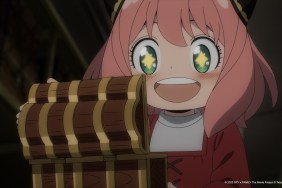
Frequent reader and commenter “Ian” asked in yesterday’s Friday box-office report that I post something discussing the ending to this weekend’s new release Source Code. He said he’d read a few different interpretations and thought it would make for good discussion. This caught me entirely by surprise. Primarily because I didn’t think there was anything to interpret.
Loving the prospect of a good discussion and curious to see what people were saying, I took to the web, genuinely interested in reading what possibilities I was overlooking.
However, before we dig into any interpretations let’s remind ourselves of what we’re discussing. Obviously, if you haven’t seen the film yet you’re entering massive spoiler territory. I’m also not going to explain the film (the clip to the right may help if you need assistance there). That said, let’s get to it, and if I’m a bit off on something, please excuse me, I saw the film over two weeks ago.
At the end of Source Code Colter Stevens (Jake Gyllenhaal) discovers the bomber’s identity, relays the information and the bomber is caught before he can detonate a bomb in the middle of Chicago. From here his character convinces Colleen Goodwin (Vera Farmiga) to send him into the “Source Code” one last time in an attempt to save the passengers on the train by disarming the bomb, capturing the bomber and turning him into the authorities.
Colter wants to do this despite the fact “Source Code” creator Dr. Rutledge (Jeffrey Wright) has told him it’s a futile effort as he’s only got the last eight minutes of Sean Fentress’s life to live since the world, as far as Fentress was concerned, ended when the bomb originally exploded and Fentress died. Based on that theory, there’s nothing Colter can do but relive the eight minutes all over again, save the train or not, and return back to the film’s narrative reality after eight minutes.
Despite his request being denied by Rutledge, Colleen goes against orders and sends Colter back one last time. This time he disarms the bomb, captures the bomber and — this is important — sends Colleen a text message letting her know a crisis has been averted and the “Source Code” works.
As the eight minutes allotted him end time appears to freeze. At the same time Colleen, in the film’s narrative reality, terminates Colter’s life. The film then switches back to Colter in the “Source Code” where time resumes, he gets off the train with Christina (Michelle Monaghan) and they live happily ever after.
The scene is set… Let’s discuss…
Looking around the Internet I found Christopher Campbell’s interpretation of the ending over at indieWire. He believes that when Colter’s eight minutes are up “this is when [Colter] would leap out of Sean’s body and return to his own body” back at the lab and everything we see from that moment on is his “heaven” for Colter. He also believes Sean Fentress is still alive and is adamant in saying Colter is “not in two places at once.”
Next, I have one more piece to add to the discussion as Christy Lemire (co-host of Ebert Presents at the Movies), Matt Atchity (editor-in-chief of Rottentomatoes.com) and Ben Mankiewicz (host of Turner Classic Movies) discuss the ending. You can watch that to the right and I’ll bring it up shortly.
I have to admit, I was surprised by both of these discussions. I, perhaps naively, thought the film was 100% straight-forward and obvious. Duncan Jones and I even discussed it at length in my interview and to put it simply, he says quite clearly, “[T]echnically it’s a parallel reality film.”
Let me explain it as I see it…

You see, each time Colter goes back into the “Source Code” he’s creating a new parallel reality. The first seven times in, he dies as the infographic to the right (click to enlarge) suggests. So essentially, what Dr. Rutledge has created is a method of time travel, but a method of time travel that not only sends its user back in time, but creates a new parallel reality that the user now inhabits and will, theoretically, continue on with or without said user.
So, when Colter goes back for a final time and stops the bomber and saves the train it is here where he will now live on forever, his consciousness in the body of Sean Fentress in a new alternate reality. Meanwhile, back in the narrative reality Sean, Christina and everyone else on the train are still dead, but the bomber is captured, the “Source Code” is proven to work and Colleen terminates Colter’s comatose life.
So, when Christopher from indieWire says Colter was “not in two places at once” I see it differently. Colter isn’t in one or two places, he’s in several places at once. Colter’s physical body not only exists in the narrative reality, but in every single parallel reality created by the “Source Code”.
As reason would have it, Colter’s consciousness exists in each parallel reality as well. The only place where we know neither his physical body or consciousness exists is in the film’s narrative reality where Colleen ends what’s left of his life.
To answer Christy Lemire’s question from the video above where she wonders what happened to Sean, the answer is simple… he’s dead. Sean (or his body, depending on how you want to interpret it) dies in Colter’s first seven trips into the “Source Code” and he’s already dead in the film’s narrative reality. In the final trip Sean’s body survives, but it’s occupied by Colter’s consciousness.

Now I know that’s a lot of rambling on my part. I read and re-read it several times, hoping it was somewhat understandable. But if not, perhaps this quick summation as Jones described it in our interview will help:
[T]echnically it’s a parallel reality film, but it is also time travel. It’s parallel reality, but the reality we’re going to, we’re going to a past event in that parallel reality. We’re in this world, Vera Farmiga and Jeffrey Wright are sending him to what they think is the last eight minutes of someone’s life, captured in a victim’s brain state, in Shawn Fentress’s brain state, but what they’re actually doing — by the end of the film — is they’re accessing a parallel reality, but still having to travel backwards in it because they’re having to go to this event on the train. Then he is able to create this new reality every time he gets sent to a new “Source Code.”
After that, if you still want more evidence to support how I see it, there are two things that give even further clarification.
The first is something Jones and I talked about briefly, but I didn’t include in the interview. When you watch the movie again you’ll notice during the opening credits when the words “Source Code” show up, a line is drawn across the bottom of the screen and as it continues a second line diverts off into a tangent, symbolizing the alternate reality. This was just a sort of second-time around clue Jones included in the film for those that watch it again.
Second is the text message. The text Colter sends is received in the final alternate reality and received by an alternate Colleen. It tells her the “Source Code” works and a crisis was averted. Shortly thereafter you hear Rutledge in his office say, “One day a crisis will come and the ‘Source Code’ will have its day in the sun.” He says this because in this reality — the parallel reality where Colter stopped the first bomb from going off — the “Source Code” was never used. It is here Colter’s consciousness exists in two places. His consciousness resides in the body of Fentress as well as in his body in the lab, waiting until a crisis comes along and the “Source Code” program can be used for the “first” time.
This “two consciousnesses in one place” aspect is certainly something I’m sure many will debate. However, it is clear Colter’s consciousness still resides in Fentress’s body as he and Christina visit the “Cloud Gate” sculpture and while we see Colter while they’re walking and talking, Colter sees Sean’s face reflected in the sculpture. I’m sure some will theorize this creates some world-ending paradox, but as far as the film is concerned it seems to work just fine.
Whew! That took a lot longer than I thought it would, and now for you to add your thoughts. Do you see it differently?
The great thing about movies is that it doesn’t matter what I think or what the director or screenwriter thinks. All that matters is that your interpretation works for you, and honestly, I am more interested in reading alternate interpretations for Source Code than I was for Inception. So hit me with it.









